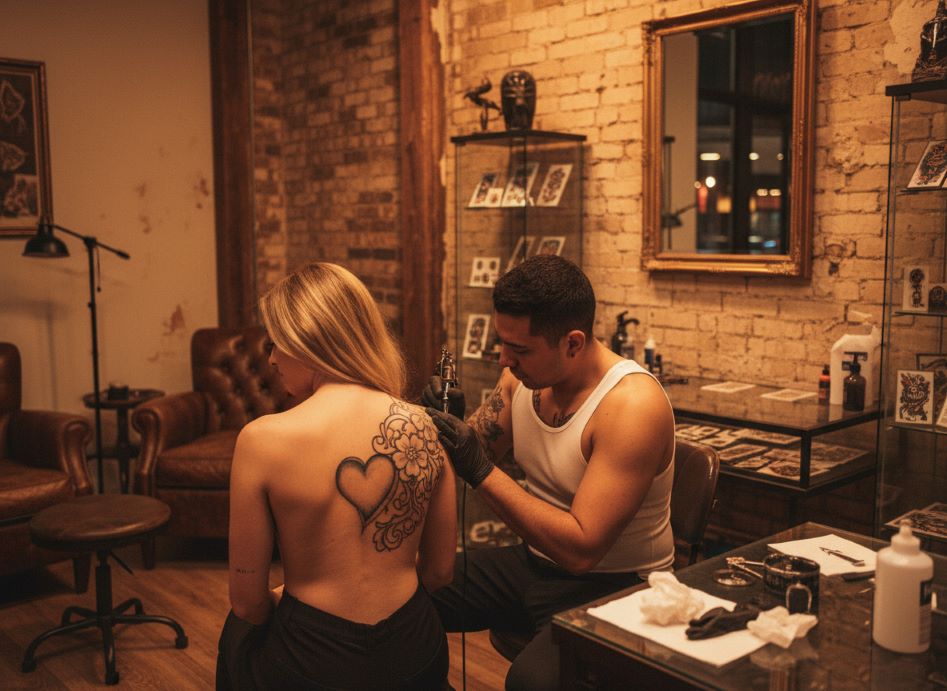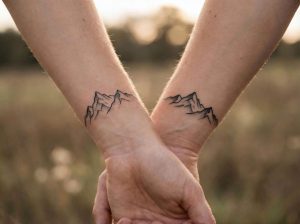So here you are, looking at that tribal armband you got in 1997, or maybe the name of a person that makes you shudder when you catch a glimpse of it in the mirror. The first thing to know is that cover-up tattoos have gone from some sort of desperate attempt to be discreet, to being a celebrated art form, and trust me when I say, current methods will leave even your tattooed forefathers, the original ink masters, in amazement.
What Makes a Successful Tattoo Cover-Up
The Art of Tattoo Transformation
Covering an old tattoo takes a lot more skill than new work on uncontested canvas. Your artist has to plan ahead, think like a chess grand master. You know this situation, it can’t just be erased off the skin and replaced with something new, it needs to be absorbed, incorporated, or hidden under something else (kinda like a catchy, half-remembered tune). The old tattoo becomes part of the new design’s genetic make-up; think of painting over a Renaissance fresco with something you hope is equally admirable.

The mechanics are rather fascinating: Black ink is the Goliath of pigments and is virtually impossible to lighten by any significant degree at the time of the cover up. The second-place colors here are, you guessed it, green and blue, and after those, red and yellow are more-likely candidates. This ranking determines which kind of cover-up can even be attempted. Changing a solid, black panther tattoo into a delicate butterfly is not much different than trying to play Mozart on a tuba: it is possible, but nobody’s first choice.
Cover-Up Strategies and Techniques
Laser Fading: Preparing Your Skin
Laser removal has changed the cover-up equation, though probably not like you think. Instead of utterly annihilating the original tattoo, the complicated process of multiple sessions fades the tattoo for a new tattoo at an anticipated layer of skin. But rather savvy clients will instead choose to have the tattoo faded as much as possible on their skin, THEN, get covered in. In just three or four sittings, you can fade a dark tattoo sufficiently to enlarge your artistic options dramatically. The idea is much like tenderizing meat before cooking, not that you remove the ingredient, but make it easier to work with.
Most successful tattoo cover-ups have some similar characteristics. They are larger than the original tattoo, sometimes more than a lot larger—typically at least 25% larger. They employ darker colors that can cover or (sometimes) absorb the old dark ink. They also work with the design placement and configuration of the old tattoo rather than against it. Compositions of Japanese or Oriental waves, florals with lots of layering, or geometric patterns tend to be the best at this type of artful deception.
Planning Your Cover-Up Consultation
What to Expect at Your Consultation
When you first meet with an artist to cover a tattoo, be prepared for honesty that might sting just a little. An artist that has honed their craft will probably not say “yes” to everything that you have pinned on Pinterest. They will evaluate your skin tone, evaluate the depth and darkness of the original piece, and talk you through what is reality and what is possible during your consultation.
The best tattoo artists truly excel at covering or transforming tattoos. They have spent years understanding how colors interact, what techniques may work for scarring or raised skin, and composing solutions that lead to distraction from what lies beneath. Like a stage magician, they realize that to deceive, it has to be well crafted.
Size is often incredibly important. That cute little rose is not going to cover a sprawling back tattoo, however optimistic you may feel. Most cover-ups need to be at least 25% larger than the original. In some instances it may need to be larger than that. Your ankle tattoo may end up expanding up your calf and that shoulder tattoo? Could transform to a half-sleeve. Just think about whether or not you’re really ready for this permanent decision.
Color Selection for Cover-Ups
Black and Grey vs Color Tattoos
Black and grey tattoos are the king of cover-ups! They can go darker than any color, wear better as they age, and look great on social media (and that matters to the majority; let’s be honest). A good tattoo artist can create astonishing depth with black ink and its varying dilutions, from the lightest of whispers to the darkest of shadows.
This isn’t to say, “no” to color. Rich, jewel tones (deep purples, forest greens and navy blues) can work well when used in a layered way. The trick is to stay away from anything light or bright next to the old tattoo’s darkest spots. Trying to tattoo buttercup yellow over solid black ink, for example, is pointless and very likely to leave you disappointed with a muddy mess.
Best Cover-Up Tattoo Designs
Japanese, Floral, and Geometric Styles
Some design themes have proven themselves again and again when it is cover-up tattoo time. Japanese-themed tattoos are at the top; dragons, phoenixes, cherry blossoms, koi fish… they work because the traditional style principles will include strong outlines and the use of negative space where appropriate. Water and cloud elements within Japanese work can help do the job of covering up the past sins of your tattoo.
Floral tattoos have exploded in popularity as a cover-up tattoo theme, and for good reason. The petals and leaves create natural opportunities for dark shading when needed, and lighter detail elsewhere. For example, a rose’s deep down dark shading can completely swallow up a name or small symbol. Mandala and geometric styles can do the same by using a dense pattern and repetition to overwhelm the eye and its ability to look at what was previously there.
Creating lifelike human portraits, or even equestrian or wildlife-related tattoo work is not only technically demanding, but can also be an impressive sight to behold. For example, the mane of a lion is a ready-made option to incorporate tonal variety as well as textural variation, while a raven’s feathers showcase a natural avenue to dark patterns and overlapping detail. A successful cover-up animal tattoo only works if the artist knows precisely where to indicate the densest fur or shadow.

Avoiding Cover-Up Mistakes
Common Errors and How to Prevent Them
The biggest tragedy in getting a cover-up tattoo happens when someone is trying to rush everything. The artist hasn’t spent the necessary time imagining the composition and figuring out placement, or the client is impatient with the laser fading process and doesn’t undergo the appropriate number of laser treatments beforehand and it simply results in a muddy tattoo with the old and new images muddled—neither being visible to the eye and it just becomes a confused smudge that shouts “regret” at the viewer louder than the first tattoo.
Another frequent catastrophe is selecting an artist who specializes in fine line work and delicate tattoo pieces to cover a significant tattoo. This is akin to asking a portrait miniaturist to paint your house. Totally different skills. Looking for a cover-up specialist who can show an extensive portfolio of cover-up work is advisable including before and after pictures. These cover up tattoo veterans understand the unique demands and possess techniques that have been developed specifically for using tattoo ink on top of a pre-existing tattoo.
Sometimes tattoo blowouts or botched cover-ups require a 2nd cover-up, the “double-down” approach. This usually means even less options afterwards, and almost always requires laser work regardless to resolve the complicated nature of ink on ink. The cost in time and money is far better invested the first time than the second time where there typically are exponential headaches thereafter.
Healing Timeline and Aftercare
What to Expect During Recovery
“Patience is a virtue,” as they say—and never more true than when it comes to doing tattoo cover-up work. Large pieces often need multiple sessions, and can take anywhere from months to years. When planning cover-up work, it’s important to keep in mind the healing time required for the skin between appointments. Typically you want to allow 4-6 weeks in-between sessions. Rush this process, and you may be left with scar tissue, blowouts, or poor ink retention.
The additional factor with cover-up healing is intensity, and the feeling overall can be a little more intense than fresh work, as the artist may have to work the ink a little more firmly into skin that’s already been tattooed. Some areas may feel more tender or take longer to heal properly according to skin healing research. Therefore, following the written aftercare instructions is absolutely crucial; if you get an infection on a cover-up or it doesn’t heal properly, it could heal unevenly or leave you with patchy ink, which is very difficult to fix. The American Academy of Dermatology provides excellent guidance on proper tattoo aftercare protocols.
Cover-Up Tattoo Cost Guide
Pricing and Investment Expectations
When it comes to cover-ups, the cost is typically going to be more than the fresh work; for obvious reasons. Additionally, you are paying for the expertise and experience of cover-up artistry, longer appointment times, and often more total area. That tiny wrist tattoo you want covered might end up being a piece all the way halfway up your forearm—and the time and expense increases exponentially.
Quality work from professional artists experienced in cover-ups will typically cost anywhere from £100-200 per hour in the UK, and similar rates will apply in the US or similar Western countries. Regardless of your geographic location (US, UK, elsewhere), if you are working on something large and meaningful, to change a tattoo you would certainly expect to pay upwards of several thousand pounds. And remember too that you may be adding several sessions of laser removal or fading (£50-200 each), all of a sudden your investment is going to be considerable. However, you are correcting a mistake that you presumably have to look at for the rest of your life—it’s probably worth the investment to fix it correctly.
The Emotional Journey of Cover-Ups
Psychology Behind Tattoo Transformation
A note about covering up tattoos is that there is an emotional journey that goes along with it. Oftentimes people may have real emotional pain to face, as the tattoo may be a reminder of old relationships, mistakes, or just changing tastes. The physical change may not be enough where the meaning has no value to it or connection to the cover-up. Often, clients remark of their sense of freedom from the cover-up tattoo—they feel they have regained some ownership over their body and life story.
Some cover-ups were approached with a very clear purpose, such as covering an ex-partner’s name or a past gang affiliation with a sun or such symbolism with a totally new tattoo. Some people just want something that is beautiful and is in the same real estate. Neither of these approaches are wrong, and the key relationship component for either person is to leave the studio knowing they are happy with their new tattoo, and they are not conflicted or negatively reminded about the cover tattoo.
Finding the Right Cover-Up Artist
Research and Portfolio Evaluation
The search for the right practitioner is the key stage, so you want to be thorough and perhaps a little obsessive. So take some time to scroll through their Instagram pages and slowly lose your marbles. Visit shops. Ask questions regarding their technique when covering a tattoo. Any experienced cover-up artist worth their weight should be happy to answer your questions about their cover-up techniques, previous work, and trouble spots they may see with your particular piece.
You may need to be flexible with location/geography. The best tattoo cover-up specialists usually have a month long waiting list. You may even need to travel to another city or even a different country for consultations with other artists for tattoo cover-ups. When you’re talking about something that is permanent on your body, the inconvenience doesn’t matter.
Red flags could be if your artist suggests anything is possible, you feel they won’t be honest about likely limits, or if they seem to just want to get it done fast. Trust your instinct, because this person will literally mark you for life.
Final Thoughts: From Regret to Masterpiece
Your Path to Tattoo Transformation
Tattoo cover-ups involve technical difficulty and artist opportunity. That which was once considered to hide an unwanted piece of art can become a much more captivating piece. The ideal tattoo covers up, but also transforms to create a truly beautiful piece of art from what was simply regrettable.
The cover-up process requires time, investment, and setting of proper expectations. Whether or not you choose to proceed with your cover-up or not, you can simply walk into any respectable tattoo parlor and ask to see their photos of cover-up work. The changes can be incredibly stunning—solid black blobs into beautiful roses, the wrong spelling of someone’s name lost within a massive floral mandala, youthful indiscretions lost in highly cultivated pieces of artistry.
The mistakes from your past do not have to be permanent fixtures. With the right hands, process and commitment, your regrettable ink could become something you don’t mind showing off….which is, when you think about it, the essence of tattoos.




